Infectious Deseases
Basic Research
Surveillance
Information
- Details
![]() Pathogen Genomics Center, National Institute of Infectious Diseases.
Pathogen Genomics Center, National Institute of Infectious Diseases.
Analysis of whole genome sequences provides information that is useful for tracing back infection using genome-wide SNVs among clusters. During the primary wave, local public health centers were able to identify likely COVID-19 patients and their close contacts within location-specific clusters by conducting active epidemiological surveillance using the keywords “Wuhan, Hubei, and China.” Just as the situation had begun to improve around mid-March, a large number of new COVID-19 patients were diagnosed, many of with unclear infection routes. Tracing the infection routes was difficult because some Japanese cases had no recent history of travel to China or any country outside Japan. The SARS-CoV-2 haplotype network analysis suggested that the second wave of COVID-19 cases could have been imported via the returnees from EU, North America, or other countries.
Read more: An epidemiological study of the SARS-CoV-2 genome in Japan
- Details
October 5, 2016
This international collaborative project by VLP Therapeutics, Nagasaki University and National Institute of Infectious diseases (NIID), supported by Global Health Innovation Technology [GHIT] Fund, is a pre-clinical study to investigate safety and immunogenicity of a virus-like particle (VLP)-based vaccine against Dengue virus infection.
- Details
Tetsuro Matano, AIDS Research Center, April 2, 2013
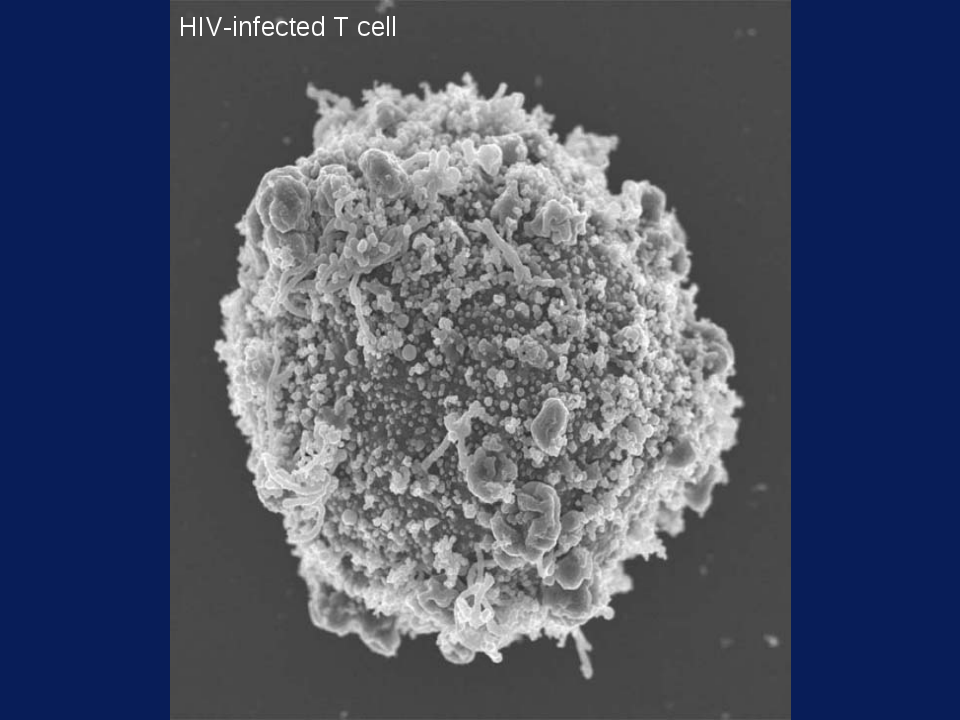 The New York-based International AIDS Vaccine Initiative (IAVI) and the Japan-based biotech DNAVEC Corporation announced the start of a Phase I clinical trial of an HIV vaccine candidate using Sendai virus (SeV) vector at three locations including England and Rwanda. The SeV vector AIDS vaccine system has been developed by AIDS Research Center, National Institute of Infectious Diseases and Institute of Medical Science, University of Tokyo.
The New York-based International AIDS Vaccine Initiative (IAVI) and the Japan-based biotech DNAVEC Corporation announced the start of a Phase I clinical trial of an HIV vaccine candidate using Sendai virus (SeV) vector at three locations including England and Rwanda. The SeV vector AIDS vaccine system has been developed by AIDS Research Center, National Institute of Infectious Diseases and Institute of Medical Science, University of Tokyo.
Press release from IAVI on April 1, 2013
http://www.iavi.org/Information-Center/Press-Releases/Pages/IAVI-AND-PARTNERS-INITIATE-PHASE-I-TRIAL-OF-A-NOVEL-AIDS-VACCINE-REGIMEN.aspx
Information on this project in IAVI Web
http://www.iavi.org/Information-Center/Publications/Pages/AIDS-Vaccine-Development-in-Japan.aspx
- Details
A. 使用検体パネル
・HCV陽性検体パネル (2017);80検体
・HCV陰性検体パネル (2017);70検体
B. 評価キット
・HCV抗体キット;13キット
力価分類あり;7キット
力価分類なし;6キット
・HCV核酸キット;5キット
・HCVコア蛋白質キット;2キット
C.評価結果
(1) 各キットによるパネル検体の検出率
HCV抗体キット(力価分類あり)
|
|
陽性検体パネル (N=80) |
陰性検体パネル (N=70) |
|
ルミパルス HCV |
80 (100%) |
70 (100%) |
|
ルミパルスプレスト HCV |
80 (100%) |
70 (100%) |
|
ルミパルスII オーソ HCV |
80 (100%) |
70 (100%) |
|
ルミパルスプレスト オーソHCV |
80 (100%) |
70 (100%) |
|
アキュラシード HCV[II] |
80 (100%) |
70 (100%) |
|
HISCL HCV Ab 試薬 |
80 (100%) |
70 (100%) |
|
AIA−パックCL HCVAb |
80 (100%) |
70 (100%) |
HCV抗体キット(力価分類なし)
|
|
陽性検体パネル (N=80) |
陰性検体パネル (N=70) |
|
HCV・アボット(アーキテクト) |
80 (100%) |
70 (100%) |
|
Ab・アボット(Alinity) |
80 (100%) |
70 (100%) |
|
エクルーシス試薬 Anti-HCVⅡ |
80 (100%) |
70 (100%) |
|
ケミルミHCV抗体 |
80 (100%) |
70 (100%) |
|
HISCL HCV Ab II 試薬 |
80 (100%) |
70 (100%) |
|
Eテスト「TOSOH」II(HCVAb) |
80 (100%) |
70 (100%) |
HCVコア蛋白質キット
|
|
陽性検体パネル (N=80) |
陰性検体パネル (N=70) |
|
HCV Ag・アボット |
80 (100%) |
70 (100%) |
|
ルミパルス オーソHCV抗原 |
78 (97.5%) |
70 (100%) |
HCV核酸キット
|
|
陽性検体パネル (N=80) |
陰性検体パネル (N=70) |
|
アキュジーンm-HCV |
80 (100%) |
70 (100%) |
|
Alinity m システム HCV |
80 (100%) |
70 (100%) |
|
Cobas TaqMan HCV「オート」v2.0 |
80 (100%) |
70 (100%) |
|
コバス6800/8800 システム HCV |
80 (100%) |
70 (100%) |
|
アプティマ HCV |
80 (100%) |
70 (100%) |
(2) HCV抗体キットによる測定
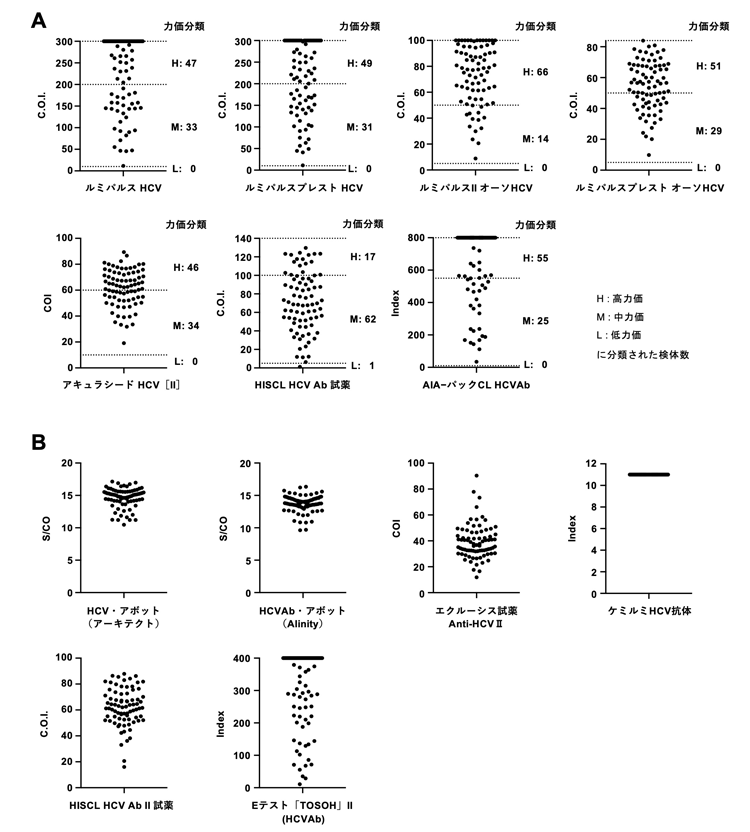
(3) HCV核酸キットの相関
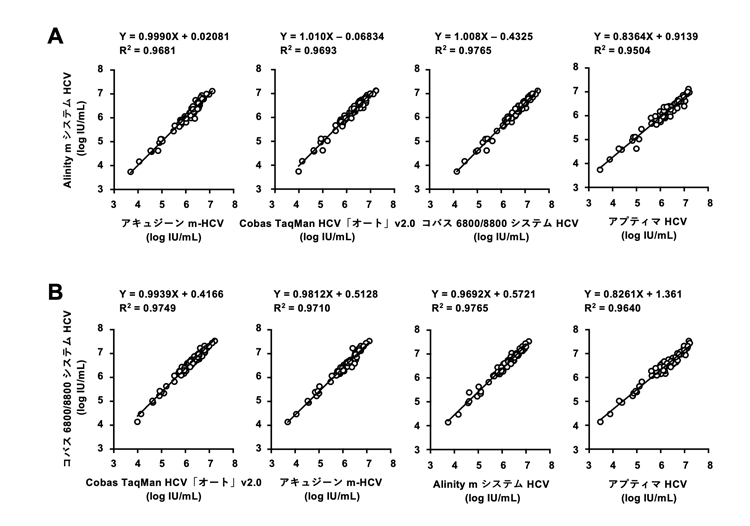
(4) HCVコア蛋白質キットの相関
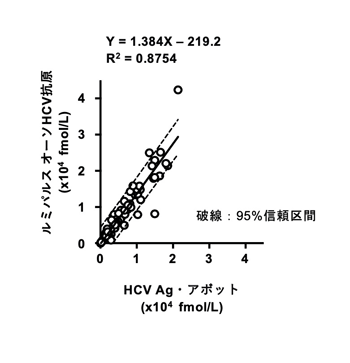
(5) HCV核酸キットとHCVコア蛋白質キットの相関
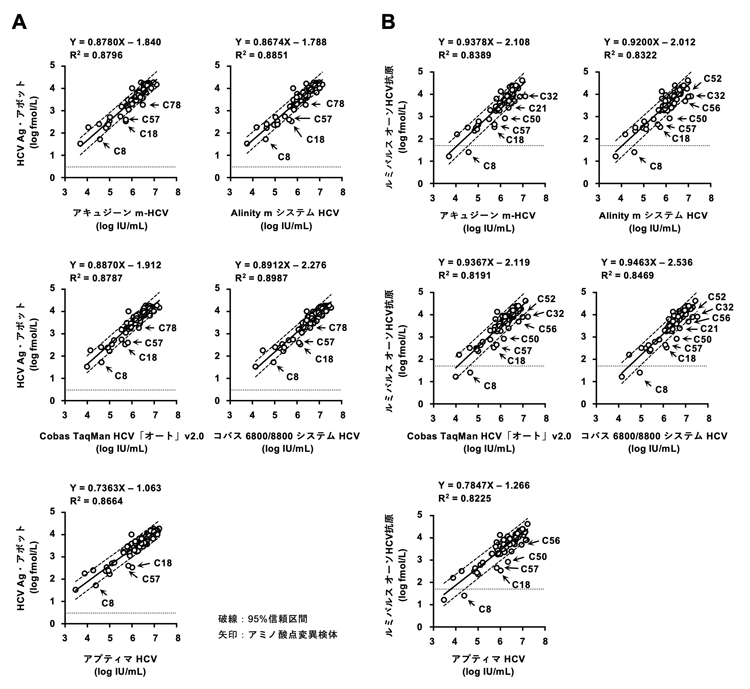
(6) 本検討で使用したHCV検体パネルについて
本検討で使用したHCV検体パネルは「献血血液等の研究開発等への使用に関する指針」に基づく公募により日本赤十字社から譲渡された献血血液を用いて作製されています。
また、本論文で検討を行ったHCVゲノムのコア領域の配列は以下のAccession No.で公開されています。
・LC658661- LC658679.
D.発表論文
Performance Evaluation of In Vitro Screening and Diagnostic Kits for Hepatitis C Virus Infection.
Murayama A, Momose H, Yamada N, Matsubayashi K, Muramatsu M, Hamaguchi I, Kato T.
Front Cell Infect Microbiol. 2022 Feb 3;11:793472. doi:10.3389/fcimb.2021.793472.
PMID: 35186779
本論文はCreative Commons Attribution License, CC-BY 4.0のもとに発表され、
Creative Commons CC0 1.0 Public Domain Dedication waiverのもと配信されました。
E.利益相反について
上記論文の著者らは本研究について開示すべき事項はありません。
- Details
| ■To read the report |
|
| Annual report was divided into PDF document of each divison in NIID. We recommend to use Adobe Reader (ver. 6 or higher) to read the documents. |
|
- Details
| ■To read the report |
|
| Annual report was divided into PDF document of each divison in NIID. We recommend to use Adobe Reader (ver. 6 or higher) to read the documents. |
|
